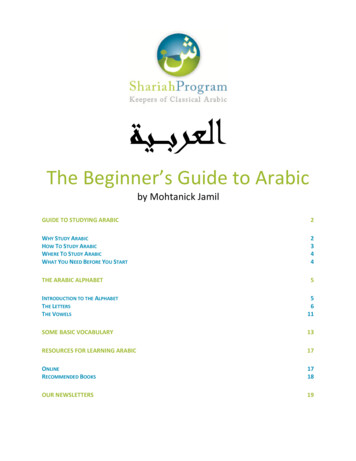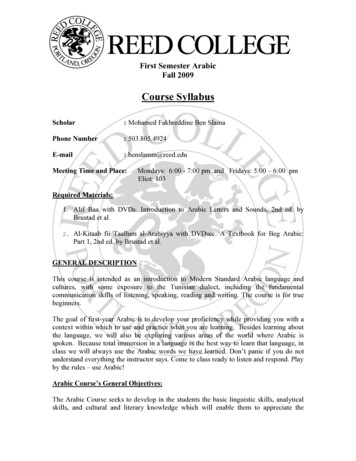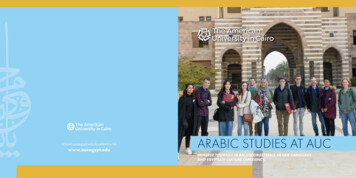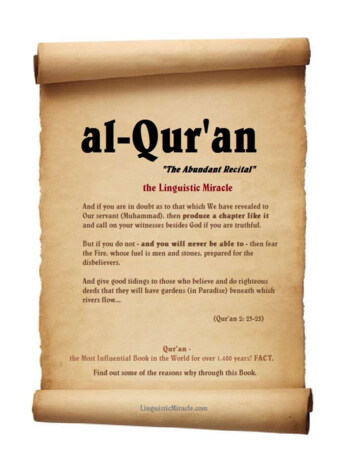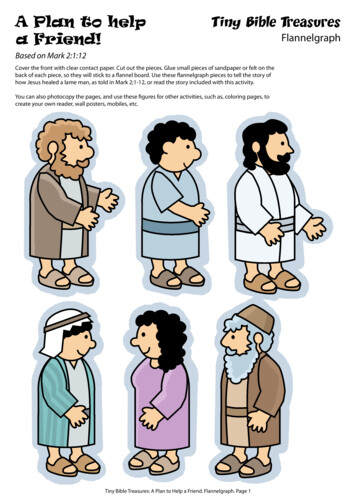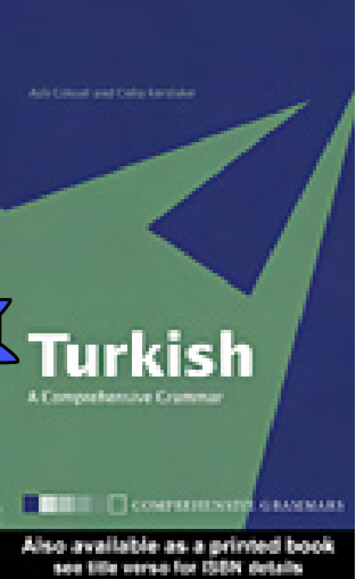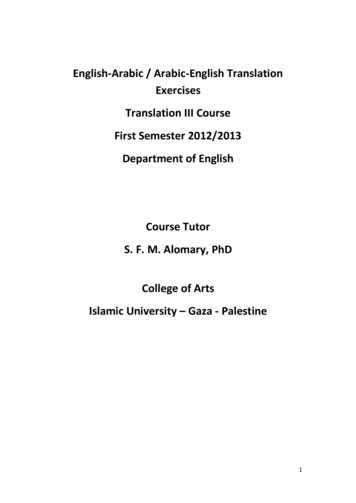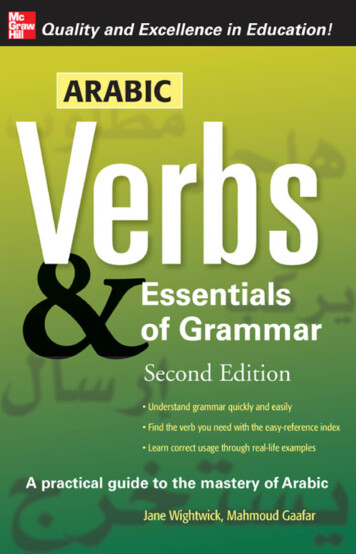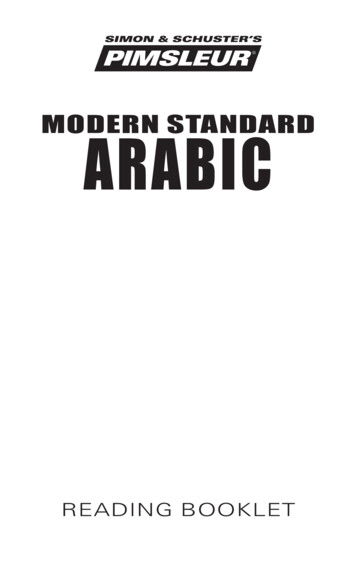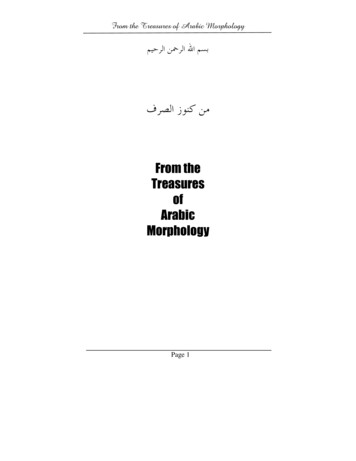
Transcription
From the Treasures of Arabic Morphology From theTreasuresofArabicMorphologyPage 1
From the Treasures of Arabic MorphologyCopyright 2005 Madrasah In’āmiyyahAll rights reserved. No part of this book may be reproduced, stored ina retrieval system, or transmitted in any form, or by any means,electronic, mechanical, photocopying, or otherwise, without the priorpermission of Madrasah In’āmiyyah, except in the case of briefquotations embodied in critical articles and reviews.Typeset on Times New Roman 12 and Traditional Arabic 18 byAcademy for Islamic Research, Madrasah In’āmiyyah, Camperdown,KwaZulu Natal, South Africa.Page 2
From the Treasures of Arabic MorphologyTitleFrom the TreasuresMorphologyAuthorMoulānā Ebrāhīm MuhammadFirst EditionRamadān 1427 A.H.October 2006Academy for Islamic ResearchMadrasah In’āmiyyahP.O. Box 39Camperdown3720South AfricaPublished byTel 27 031 785 1519Fax 27 031 785 1091emailal inaam@yahoo.comPage 3ofArabic
From the Treasures of Arabic MorphologyContentsIntroductionMorphology or Etymology?Some Useful TermsArabic TermsThe Types of WordsTransitive and Intransitive VerbsPositive and NegativeActive and PassiveThe Second Category of VerbsExercise 1Types of NounsThe Scales of VerbsExercise 2The Categories of Triliteral VerbsExercise 3The Perfect Active ( )Exercise 4The Perfect Passive ( )Exercise 5The Imperfect ( )Exercise 6The Imperfect Passive ( )Exercise 7The ( !" # )Exercise 8The ( )Exercise 9The (%&) and (' #) of EmphasisExercise 10The Imperative ( ()Exercise 11Page 4
From the Treasures of Arabic MorphologyThe Prohibition ( )Exercise 12The Derived Nouns ( )* , -. )The active participle (/0 1 2 )Exercise 13The passive participle ( 1 2 )Exercise 14The Elative (/ 1* 2 )The ( ! 1")The Noun of the Instrument ( 3 2 )Exercise 15The Adverb ( 4 2 )Exercise 16The Intensive Adjective ( 5 ! 5 ")Exercise 17The Categories (6 () of VerbsThe (6 () of (7 8 9:9)The First (6 )The Second (6 )The Third (6 )The Fourth (6 )The Fifth (6 )The Sixth (6 )Exercise 18The (6 () of (; ? 9:9)Construction of the Derived NounsThe Abbreviated Paradigm of each (6 )( @ 6 )Exercise 19Page 5
From the Treasures of Arabic Morphology(/ 1A 6 )Exercise 20( B0 1 6 )Exercise 21( 1#@ 6 )Exercise 22( * @ 6 )Exercise 23( : @ 6 )Exercise 24(/C 1A 6 )Exercise 25(/0 1A 6 )Exercise 26( 1*2@ 6 )Exercise 27( @ 6 )Exercise 28( : @ 6 )Exercise 29( C @ 6 )Exercise 30Four Root-Letter VerbsThe (6 () of (DEB ; ? 9:9)The Classification of VerbsExercise 31The Derived Forms ofVerbsExercise 32Exercise 33Exercise 34Other Derived FormsFourPage 6Root-Letter
From the Treasures of Arabic MorphologyExercise 35The Seven CategoriesExercise 36The Rules of ( F )Rule 1Rule 2Rule 3Rule 4Rule 5Rule 6Rule 7Rule 8Rule 9Rule 10Exercise 37The Orthography of the HamzahThe Paradigms of ( F )Exercise 38Exercise 39Exercise 40Discussion of (G F )Discussion of (%: F )Exercise 41The Rules of (/* )Rule 1Rule 2Rule 3Rule 4Rule 5Rule 6Rule 7Rule 8Rule 9Page 7
From the Treasures of Arabic MorphologyRule 10Exercise 42Rule 11Rule 12Rule 13Rule 14Rule 15Rule 16Rule 17Rule 18Rule 19Rule 20Rule 21Rule 22Rule 23Rule 24Rule 25Rule 26Exercise 43The Paradigms of ( H )Exercise 44The Paradigms of ( ()Exercise 45The Paradigm of ( I ()Exercise 46The Paradigms of (JK #) and (L 1 )Exercise 47Exercise 48Combination of ( F ) and (/* )Exercise 49The Rules of (L0 )Rule 1Rule 2Page 8
From the Treasures of Arabic MorphologyRule 3Rule 4Rule 5Exercise 50Exercise 51A Combination of ( F ) ,(L0 ) and (/* )Exercise 52Challenging WordsSpecial Meanings (P " O) of Each (6 )The (P " O) of ( # 6 )The (P " O) of (6 6 )The (P " O) of (Q- 6 )The (P " O) of (% 6 )The Derived CategoriesThe (P " O) of ( @ 6 )The (P " O) of (/ 1A 6 )The (P " O) of ( B0 1 6 )The (P " O) of ( * @ 6 )The (P " O) of ( 1#@ 6 )The (P " O) of ( : @ 6 )The (P " O) of (/ 1A 6 )The (P " O) of (/0 1A 6 )The (P " O) of ( 1*2@ 6 )The (P " O) of ( @ 6 )The (P " O) of ( : @ 6 )The (P " O) of ( C @ 6 )Application of the Special MeaningsBibliographyPage 9
From the Treasures of Arabic Morphology IntroductionArabic Morphology ( RR RRB0)is a branch of ArabicGrammar dealing with word-forms and patterns. It ishighly essential for the incumbent student of Arabic tolearn this science in order to be proficient in the language.Acquiring an understanding of word patterns is of primeimportance in learning the language.This is a comprehensive book dealing with all theimportant aspects of the subject. If a student has to studythis book thoroughly, he would develop a very goodfoundation in this science and it would absolve him of theneed to study any further books on the subject.The Arabic names of morphologic terms have beenadopted instead of the Urdu forms commonly found in thetext books of Islamic seminaries. Thus I have used theFBS G0) instead of ( RFB GR0). Similarly, insteadof writing (TRR ), the correct Arabic form of ( R )has been used while the term ( RR ) is used instead of( RR ) which is incorrect. This will enable the student toterm (learn the correct Arabic terms from the initial stages of hislearning.Included also is a collection of rules of word-changeswhich affect many Arabic verbs and nouns. The rules havebeen clearly explained with examples and a step by stepPage 10
From the Treasures of Arabic Morphologymethod as to how a word is changed from its original formto its present one.It is hoped that this book will be beneficial for the studentsof Arabic Grammar and Morphology and simplify the pathto understanding the intricacies of the language. Āmīn.For a detailed discussion on the name of this subject,whether it is called Morphology or Etymology, refer toAppendix A at the end of this book.Some Useful TermsConjugation: A paradigm, class, or table of verb forms insuch inflected languages as Latin and French, whereelements are distinguished from each other by patterns ofinflection relating to tense, person, number.1Declension: A term used to describe the case system ofnouns and other words.2Inflection: The variation or change of form that wordsundergo to mark distinctions of case, gender, number,tense, person, mood, voice, comparison.3Linguistics and Philology: The study of language.Paradigm: pronounced (pa-ra-dime), in grammar, a set ofall the (especially inflected) forms of a word (write, writes,wrote, writing, written), especially when used as a modelfor all other words of the same type.41The Oxford Companion to the English Language, p. 256, 1992.Ibid, p. 281.3Websters Third New International Dictionary, vol. 2, p. 1160.4The Oxford Companion to the English Language, p. 747, 1992.2Page 11
From the Treasures of Arabic MorphologyArabic TermsThe following are some of the Arabic terms usedfrequently in this book. It would be advisable to learnthem thoroughly as they are frequently used throughoutthe book.Term MeaningA diacritical pointUR denoting the soundof ‘a’. A diacritical point - VR denoting the soundof ‘u’. A diacritical point - WR denoting the soundof ‘i’. A diacritical point purpose of joiningpronunciationXRthat serves thetwoletters A letter having a fathah, e.g. (Y ) A letter having a dammah, e.g. ([Z ) A letter having a kasrah, e.g. (\W) inA letter having a sukûn or jazm, e.g. ( ] ) The three diacritical points, fathahdammah and kasrah are each called aharakah A letter having a harakah, e.g. (Y )Page 12
From the Treasures of Arabic Morphology ! " The first root letter of a word, also referredto as consonant or radical, e.g. the () of(Y *Y ) ! # The second root letter of a word, e.g. the ! %The third root letter of a word, e.g. the (a) &'(Word-form denoting the number, genderand mood of the verb)! * (6 () is the plural of (6 ) which refers(P) of (Y *Y )of (Y *Y )to a category of verbs belonging to oneclass. The first verb of the perfect tense( ) and the imperfect tense ( ),are used to indicate the diacritical points ofthe alphabets of the verbs.Page 13
From the Treasures of Arabic MorphologyThe Types of WordsMeaningwordExample10 2 !-noun/c Z Y3/ 42 -verb/̀Y 50 2 .particle – it is dependent on either ] WTerm / . - ,6b Y* Wan ( R2 ) or (/R ) in conveying itsmeaningWith regards to meaning and tense, a verb is of threetypes:Term6 7!8 7! 9!MeaningIndicates the occurrence ofan action in the past tense. Itis referred to as the perfecttense in English.Indicates the occurrence ofan action in the present orfuture tense. It is referred toas the imperfect tense inEnglish.a commandExample/̀RRY did./d Y 1e Y -He isdoing or hewill do./e RRY e W – Youdo.Page 14– He
From the Treasures of Arabic MorphologyTransitive and Intransitive VerbsTerm :; !MeaningIntransitive – doesnot require an objectExample ] W R R]FY - He iswalking. 4 7!Transitive - requiresan object6Y RY! e Z *Y1e Y – He isopening the door.Positive and NegativeTerm ?@A6 BMeaningpositivenegativeExample/d Y 1e Y – He is doing./d Y 1e Y & – He is not doing.The terms (T!H ) and ( 1 ) are also used.Active and PassiveTerm5 4 C DMeaningactive tense – the doerof the action is knownpassive tense – the doerof the action is notknownPage 15Example/d Y 1e Y – He is doing./d Y 1e Y done.– It is being
From the Treasures of Arabic MorphologyThe Second Category of VerbsWith regard to the root letters ( B". f ) of a verb, theyare of two types:Term 9:9 0 Meaning3 root letters ortriliteral4 root letters orquadriliteralExample Y Y #Y Y H̀ ] YEach of these two types is further divided into two categories:(1) (7 8) – the ( ) consists of root letters only, withoutany extra letters.(2) (; ? ) - the ( ) has root letters plus extra letters.This results in the following four categories:Term7 8 9:9; ? 9:97 8 0 ; ? 0 Meaning3 root letters onlyExample Y Y #Y3 root letters plus extraletters4 root letters onlygY Y*Y ] W4 root letters plus extraletters/̀Y ] Y AYPage 16 Y H̀ ] Y
From the Treasures of Arabic MorphologyExercise 1(1) Determine whether the following verbs have 3 rootletters or 4 root-letters.(a) /̀ ( (b) hY Y ] 7Y(c) hY Y OY(d) Y 1̀]0 Y(e) Y ì] K̀(2) What do the following terms mean:TermMeaning . 9:9 0 7 8; ? Page 17
From the Treasures of Arabic MorphologyTypes of Nouns(1) There are three types of nouns - (, - ):[a] , [b] D* and [c] .(2) The ( R – verbal noun) is a word that indicates theoccurrence of an action and is free of tense e.g. ( Z ] Rj ) –to assist.(3) The (D* R ) is a word derived from a verb e.g. ( b RW" Y#) –helper is derived from ( Y Y #Y).(4) The ( RR ) is neither a ( RR ) nor a (D* R ) e.g.(/c Z Y ) – man.(5) The ( RR ) and the (D* RR ) also fall under thecategories of ( 9:9), ( 0 R ), (7 R8) and (;R R ? ) likethe (/RR ). The categories mentioned under the verb like( E") etc. also apply to an ( 2 ).(6) The noun ( RR ) with regard to its letters can eitherhave three root letters (triliteral), four root letters(quadriliteral) or five root letters (quinquiliteral). It istherefore of six types:[1] (7 8 9:9) e.g. (/c Z Y ) – a man[2] (; ? 9:9) e.g. ( b YF W ) – a donkeyPage 18
From the Treasures of Arabic Morphology[3] (7 8 0 ) e.g. (6b Y )e 0Y ) – scorpion[4] (; ? 0 ) e.g. ( b k̀] KW) - paper[5] (7 8 2 l) e.g. (/c Y ] 1̀Y2) - quince[6] (; ? 2 l) e.g. (Pb ] !ZS̀] 0Y ) – aspider(7) The scholars of morphology generally deal with the(/R ) because most of the changes (P 1 RA) occur in a(/R ) while few changes occur in an ( R2 ) and none occurin a ( ).Page 19
From the Treasures of Arabic MorphologyThe Scales of VerbsThe Arabic verb is constructed from a root which usuallyconsists of three letters called consonants or radicals.These consonants form a kind of skeleton whichconstitutes the verb-stem to which prefixes and suffixesmay be added.Arabic verbs are mostly triliteral, that is, they areconstructed of three root letters. The simplest form of theverb is the third person masculine singular of the perfecttense ( R /R 1 R gRI m nR R ). In mostdictionaries, all the words derived from a triliteral root areentered under the third person masculine singular form ofthe verb.In Arabic, there are two main tenses, the perfect or pasttense ( RR ), denoting actions completed at the time towhich reference is made; and the imperfect ( RR ), forincompleted actions, referring to the present or futuretenses. The present and future tenses are thus expressed bythe imperfect form ( R ). The imperative ( R . ) maybe considered a modification of the egrammarians use the three letters of the verb (/̀RR Y ), wherethe () represents the first radical of the verb, the ( )represents the second radical of the verb and the ( )represents the third radical of the verb. This is the scalePage 20
From the Treasures of Arabic Morphology(' Y?R] W ) or standard by which the root letters of a verb aredetermined. Accordingly, the word (gY RRY* ) is on the scaleof(/̀Y ), (gZ RZ*Se Y ) is on the scale of (/d RZ 1e Y ) and (g] RZ* e (d)is on the scale of (/e Z e (d).The letter that corresponds to the (called the (ِ RYFBWS̀e ) of the (' ?RR ) is,V R ), that which corresponds to the ( ) iscalled the (ِ R FY BWS̀e Z ]R 0Y ) while the letter corresponding tothe ( ) is called the (ِ FY BWS̀e %Z & ).Example: the word (gY *Y ) is on the scale of (/̀Y ):C85) Page 21
From the Treasures of Arabic MorphologyExercise 2(1) Determine the scales of the following verbs and whateach letter represents. The first one has been done for you.(a) ( Y Y #Y)C8 E5The (') is the (FBS , ), the (o) is the ( RFBS GR0), the( ) is the ( FBS %Z & ).(b)(Q] FY 2] @W)(c)(Z *Y1e AY)(d)(6Z W] #Y)(e)(/d Y p] Y )(f)(%Y Z )(g)(gZ WE] Y )(h)(gZ qY ne Y )(i)( r̀Y2)(j)(sY Y 2Y )Page 22
From the Treasures of Arabic MorphologyThe Categories of Triliteral Verbs(FG! 6@;H ! )! * )(1) The first and third letters of a simple triliteral verb inRRE* ).The second letter or radical may be vowelled by a ( RE* ),( F ) or (t R ). The active perfect tense ( R /R 1 R ) of triliteral verbs (7 R8 R9:9) is used on threethe active tense is always vowelled with a fathah (scales:[a] /̀Y e.g. (Y *Y )[b] /̀W e.g. (QY FW 2Y )[c] /̀Z e.g. (%Y Z )(2) The conjugation of the (/̀RW ) and (/̀RZ ) forms is similarto the conjugation of (/̀Y ). RR RR ) of (/̀RRY ) issometimes (/d RY 1e Y ) e.g. ( Z *YRe1Y Y *YR ) and sometimes (/d RZ 1e Y )e.g. ( Z Z R] Y Y Y RY#) and sometimes (/d RW 1e Y ) e.g. ( 6Y Y RY 6Z W] Y ).(4) The conjugation of the (/d RZ 1e Y ) and (/d RW 1e Y ) is similar tothe conjugation of (/d Y 1e Y ).(3) The imperfect tense (Page 23
From the Treasures of Arabic Morphology R ) of (/̀RW ) is sometimes (/d RY 1e Y ) e.g.(QZ FY ] Y QY FW 2Y ) and sometimes (/d W 1e Y ) e.g. (gZ WE] Y gY W Y ).(6) The ( R R ) of (/̀RZ ) is only (/d RZ 1e Y ) e.g.(%Z Z Se Y %Y Z ).(5) The ((7) The ( ) of all three scales is (/̀W d).(8) The ( 8 ) of all three scales is (/d Y 1e Z ).(9) Based on the above-mentioned facts, there are sixcategories (6 () of (7 8 9:9) which are as follows:( Z Z ]Y Y Y #Y)(v)(6Z W] Y 6Y Y Y ) (w)(Z *Y1e Y Y *Y ) (x)(QZ FY ] Y QY FW 2Y ) (y)(%Z Z Se Y %Y Z ) (z)(gZ WE] Y gY W Y ) ({)(10) There is no rule to specify which verb belongs towhich category (6 RR ). It is based on ( RR-) – as heardfrom the Arabs. One can also ascertain whichcategory a verb belongs to from a dictionary. There arehowever certain guidelines which are as follows:[a] If the verb belongs to the category of (Page 24Y *YRR
From the Treasures of Arabic MorphologyZ *YRe1Y ) the second or third letter will be from the ( R )B )5, e.g. (gZ qY ne Y gY qY ), ( d r̀] Y r̀Y2), (QZ FY p] Y QY FY Y ).[b] If the perfect ( RR /RR 1 ) is of the form(/̀RW ), the imperfect ( R /R 1 ) is generally from thecategory of (QZ FY ]Y QY FW 2Y ).[c] If the perfect ( R / 1 ) is of the form (/̀RZ ),the imperfect ( RR /RR 1 ) is generally from thecategory of (%Z Z Se Y %Y Z ).Exercise 3To which category (6 RR ) does each of the following verbbelong:(1) (}d Y !]Y } Y Y)(2) (\Z Z *]Y \Y Y AY)(3) ( Z Y 1e Y Y W )(4) (gZ Bdie Y gY B̀k̀)(5) (sZ W ] Y sY Y 2Y ) )B ) are the following six letters:( a ,).5The (Page 25
From the Treasures of Arabic MorphologyThe Perfect Active Tense ((1) There are 14 word-forms (( RR /RR 1 ).5 RR") )of the perfect tenseAll three diacritical points or vowels(P R ) can be used on the (RFBS GR0) as is apparentfrom the above-mentioned six categories (6 ().(2) The Arab Grammarians usually begin the Perfect (/R 1 R ) and Imperfect ( R /R 1 ) conjugations with thethird person (gRRRI m), followed by the second person(gk ) and finally the first person ( BS* ).(3) Unlike English, Arabic also has a dual form for thesecond and third persons. As for the first person, the pluralform is used for both the dual and plural.(4) Hereunder follow the paradigms of the perfect tense.Note that the first three froms are for the masculine whilethe second three are for the feminine of the third person.The following six forms are for the second person, the firstthree being for the masculine and the second three for thefeminine. The final two forms are for the first person.Page 26
From the Treasures of Arabic MorphologyI?H7! 5 47! 6 7! 34 ! &'J ! (Word-form)VerbgI m n /̀Y gI m n HA B̀ Y gI m n Q ] Bd Y gI m }# T] B̀Y gI m }# HA Y*B̀ Y gI m }# Q Y Be Y n TY Be Y n HA YF*ZBe Y n Q ] *ZBe Y }# TW Be Y }# HA YF*ZBe Y }# Q j *ZBe Y BS* TZ Be Y BS* Q Y Be Y Page 27
From the Treasures of Arabic MorphologyExercise 4Conjugate the following verbs in the perfect tense ( ) in table form :(a) (gZ BW5] Y gY B̀m̀)(b) (ZpY ]Y Y pY #Y)(c) (/d *Z)e Y /̀Y*K̀)(d) (}d Y !]Y } Y Y)(e) (/d OZ ] Y /̀YO7Y )(f) (gZ *ZSe Y gY *Y )(g) ( Z B̀ ] Y Y BW0Y )(h) ( Z W ]Y Y W #Y)(i) ( ZEYp] Y Y EY Y )(j) (/d !Y)e Y /̀W!K̀)Page 28 R
From the Treasures of Arabic MorphologyThe Perfect Passive ( The ( RR RR ) )is constructed from the ( RR R ) in all triliteral verbs ( 7 R8 R9:9). If we take thefirst verb, namely the third person singular form, (/̀RR Y ), a( FR ) is rendered to the first letter, a (t R ) is renderedto the second letter while the third letter remains in itsoriginal condition. The result is (/̀RW d). No matter what the(RR )of the second letter in the active tense is, in thepassive tense it will always be ( Active – (5 S ). Examples:4 )Passive – (C D ) Y Y #Y Y W #ZQY FW 2YQY FW 2Z%Y Z %Y W dNote that the intransitive verbs can be used in the passive tense ifthey are used with a particle ((W;W ), e.g.gY qW d ) – It was taken.Page 29
From the Treasures of Arabic MorphologyI?H7! C DG! 6 7! 34 !Word-formVerbsingular masculine 3rd person/̀W ddual masculine 3rd person: W drdplural masculine 3 personrdsingular feminine 3 person ] Bd W dT] B̀W d Y*B̀ W drddual feminine 3 personplural feminine 3 person Y Be W dsingular masculine 2nd personTY Be W ddual masculine 2nd person YF*ZBe W dplural masculine 2nd person ] *ZBe W dsingular feminine 2nd personTW Be W ddual feminine 2nd person YF*ZBe W dplural feminine 2nd person j *ZBe W dsingular first personTZ Be W ddual and plural first person Y Be W drdPage 30
From the Treasures of Arabic Morphology6 K7! 5 47! 6 7! 34 !VerbPronoun/̀Y Y Y qZ B̀ Y Y YFqZ ] Bd Y Y ] qZT] B̀ Y Y Y qW Y*B̀ Y Y YFqZ Y Be Y Y j qZTY Be Y Y TY #]( YF*ZBe Y Y YF*Z#]( ] *ZBe Y Y ] *Z#]( TW Be Y Y TW #]( YF*ZBe Y Y YF*Z#]( j *ZBe Y Y j *Z#]( TZ Be Y Y Y#( Y Be Y Y Z E] #YThe words ( RY ) or (& )areusedforthenegative sense. To use(& ) with ( R ), theconditionisthatthe(& ) must be repeatedeg.( BY"& Y sY j "Y : ).The column on theright indicates how thepronouns ( I FRR ) areused with the verbs.Page 31
From the Treasures of Arabic Morphology6 K7! C DG! 6 7! 34 !Word-formVerbgI 5 /̀W d Y ' !I 5 B̀ W d Y ' !I 5 ] Bd W d Y !I 5 T] B̀ W d Y ' *!I 5 Y*B̀ W d Y P !I 5 Y Be W d Y gk TY Be W d Y ' !k YF*ZBe W d Y ' !k ] *ZBe W d Y !k TW Be W d Y ' *!k YF*ZBe W d Y P !k j *ZBe W d Y BS* TZ Be W d Y 5 Q BS* Y Be W d Y Note the Arabic terms used for the different word-forms inthis table.Page 32
From the Treasures of Arabic MorphologyExercise 5(a) Translate the following sentences:(b) What is the (' ] )d e Y K̀ Y qZ'd ] )d e ,U W Kd W ]Y ] *ZSe Y Y*!Y*Y YFqZ Y*!YBWkd 'W Y* ]!W e (v)(w)(x)(y) 1ZA TY Be ( TY #]( SY @W ] *ZHe W Z ] *Z#]( Y Be W e TW !]B̀k̀ TW #]( 1̀] *Y] FZ e @W j *ZHe W Z j *Z#]( !Y Y ] W Y Z E] #Y ] Sd ] K̀ Y F] W Y (z)({)( )( )( )(v )5 ") of the following verbs:[1] ( ' t H I2 ?. , L, B BK )[2] ( 1e #Y 3, .M, )[3] (P !2 N . O. )[4] (' [5] (; . . O. )). - P. F )Page 33
From the Treasures of Arabic Morphology[6] (; ! 2 *R- Q- , )[7] (% S B0 S. -N )[8] (I2 , T- Rt7 @ )[9] (I2 , -MNg# C r)[10] (12 UR .KMV :. . )(c) Are the following verbs ( ) or ( 8)?[1] (' ?W Y )[2] (TY Be !WKd)[3] ( j AZ ] W d )[4] ( Y Z Y)[5] ( Y# ] W Kd)Page 34
From the Treasures of Arabic MorphologyThe Imperfect ( )The Imperfect ( ) is formed by adding prefixes and/orsuffixes to the perfect tense. The prefixes can either be any of theletters ( Y ]AY( ). The suffixes may either be (' ), (' ), ( ) or just(').After adding the prefix, the first radical or letter of the verb has(' S2), e.g. the () of (/d Y 1e Y ) has a sukûn. The second lettercan have any of the three harakât, depending on which category(6 ) the verb belongs to.In the indicative case (Q ), the final vowel of the thirdFBS %&) is ( F ) in the singular form of the verb, e.g.(/d Y 1e Y ), (/d Y 1e AY), (/d Y e ( ) and (/d Y 1e #Y). For the subjunctive case ( g ), this ( F ) is changed to ( E* ), e.g. (/̀Y 1e Y ), (/̀Y 1e AY),(/̀Y e ( ) and (/̀Y 1e #Y); while for the jussive case (%? ), it isreplaced by a (' S2), e.g. (/e Y 1e Y ), (/e Y 1e AY), (/e Y e ( ) and (/e Y 1e #Y). Theradical (changes in the singular and dual forms will be discussed later.Page 35
From the Treasures of Arabic MorphologyI?H7! 5 47! 8 7! 34 !MeaningVerbHe is doing or he will do./d Y 1e Y They (2 males) are doing or they will do.'W B̀ Y 1e Y They (plural males) are doing or they will do.' ] Bd Y 1e Y She is doing or she will do./d Y 1e AYThey (2 females) are doing or they will do.'W B̀ Y 1e AYThey (plural females) are doing or they will do. Y Be Y 1e Y You (1 male) are doing or you will do./d Y 1e AYYou (2 males) are doing or you will do.'W B̀ Y 1e AYYou (plural males) are doing or you will do.' ] Bd Y 1e AYYou (1 female) are doing or you will do. Y ]BW Y 1e AYYou (2 females) are doing or you will do.'W B̀ Y 1e AYYou (plural females) are doing or you will do. Y Be Y 1e AYI am doing or will do./d Y e ( We are doing or we will do./d Y 1e #YPage 36
From the Treasures of Arabic MorphologyI?H7! C DG! 8 7! 34 !6 K7! 5 47! 8 7! 34 !6 K7! C DG! 8 7! 34 !/d Y 1e Z /d Y 1e Y & /d Y 1e Z & 'W B̀ Y 1e Z 'W B̀ Y 1e Y & 'W B̀ Y 1e Z & ' ] Bd Y 1e Z ' ] Bd Y 1e Y & ' ] Bd Y 1e Z & /d Y 1e AZ/d Y 1e AY & /d Y 1e AZ & 'W B̀ Y 1e AZ'W B̀ Y 1e AY & 'W B̀ Y 1e AZ & Y Be Y 1e Z Y Be Y 1e Y & Y Be Y 1e Z & /d Y 1e AZ/d Y 1e AY & /d Y 1e AZ & 'W B̀ Y 1e AZ'W B̀ Y 1e AY & 'W B̀ Y 1e AZ & ' ] Bd Y 1e AZ' ] Bd Y 1e AY & ' ] Bd Y 1e AZ & Y ]BW Y 1e AZ Y ]BW Y 1e AY & Y ]BW Y 1e AZ & 'W B̀ Y 1e AZ'W B̀ Y 1e AY & 'W B̀ Y 1e AZ & Y Be Y 1e AZ Y Be Y 1e AY & Y Be Y 1e AZ & /d Y e (d/d Y e ( & /d Y e (d & /d Y 1e #Z/d Y 1e #Y & /d Y 1e #Z & Page 37
From the Treasures of Arabic MorphologyExercise 6(1) To which category (6 RR ) do each of the followingverbs belong:(a) (DdB DB̀O)(b) ( WB4 B̀ )(c) ( Z! Y!0)(d) ( WB B̀ )(e) ( d4 4̀#)(2) What is the ( 5 ") of the following words:, 2 R , 42 W. %, G) S (v), 2 N . 42 O. #( (w) 1R - XV W. %, '@ (x) ] W 1e Y W \R - 2 , %, (Z), 2 N N V W. n (]) i n R ?R 2 , %, ( )/ @ , 2 R XN K2 W. ;, , , ( )' 0 , 2 4R K. 2 W. ( )Page 38
From the Treasures of Arabic MorphologyThe Imperfect Passive Tense (The ( RR R ) RR ) )is constructed from the (in all triliteral verbs (7 R8 R9:9). RR If we take thefirst verb, namely the third person singular form, (/d RY 1e Y ), aFR ) is rendered to RR ) – sign ofR :0the imperfect tense. A ( RRE* ) isrendered to the( RFBS GR0) while the ( RFBS %&)remains as it is. The result is (/d R Y 1e Z ). No matter what the( R ) of the ( RFBS GR0) in the active tense is, in thepassive tense, it will always be (a *1 ). Examples:(Active – (5 the first letter which is the (4 )Passive – (C D ) Z Z ]Y Z Y ]Z QZ FY ] Y QZ FY ] Z 6Z W] Y 6Z Y] Z Page 39
From the Treasures of Arabic MorphologyExercise 7(a) Translate the following into English:' ] Bd ] Z q /d Y 1e Y jF0Y /d ] Z & Z !YB 6Z Y ] Z Z .U Y Z FY j %Y ] Y e /d ] Z W Y Y YEFZ e W W S̀] Y e /d *Y)e Z (v)(w)(x)(y) SC ] W W ] W 'd Y B Z Y 1e Z /e qY (z)(b) Translate the following sentences into Arabic:[1] The door of the school is being opened.[2] He is being sent to Madînah.[3] The disbelievers will be defeated.[4] The car will be left on the road.[5] The book will be read today.(c) Conjugate the following verbs into the ( RRR 8):(z)aZ Y 1e Y (y)%Z ?W ] Y (x) Z Sd ] Y Page 40(w)sZ Z ] Y (v)QZ W ] Y
From the Treasures of Arabic MorphologyThe (!" # ) ) are: ('e ( ), ( ] ), ( ] ) and ('e @W). When theyprecede the ( / ), they render (g #) to the followingThe (!" #five words:gI m n /d Y 1e Y (v)gI m }# /d Y 1e AY (w) n /d Y 1e AY (x) BS* /d Y e ( (y) BS* Q /d Y 1e #Y (z)The (6 0 ' #) of the following seven words is deleted:gI m n HA 'W B̀ Y 1e Y (v)gI m n Q ' ] Bd Y 1e Y (w)gI m }# HA 'W B̀ Y 1e AY (x) n HA 'W B̀ Y 1e AY (y) n Q ' ] Bd Y 1e AY (z) }# Y ]BW Y 1e AY ({) }# HA 'W B̀ Y 1e AY ( )The following two words remain unchanged:Page 41
From the Treasures of Arabic MorphologyThe word ( ] ) changes thegI m }# Q Y Be Y 1e Y (v) }# Q Y Be Y 1e AY (w)positive imperfect tense ( T!H ) to negative ( 1 ) with emphasis. ) – the active tense and ( 8) – thepassive tense – when used with the other particles, ('e ( ), ( ] ) and('e @W) will be the same as was in the case of ( ] ).The paradigms of (Examples: ] Bd Y 1e Y 'e ( : Y 1e Y 'e ( /̀Y 1e Y 'e ( e dB Y 1e Y ] : Y 1e Y ] /̀Y 1e Y ] ] Bd Y 1e Y 'e @W: Y 1e Y 'e @W/̀Y 1e Y 'e @WHereunder follow the paradigms of ( the particle ( ] ).Page 42/ ) when used with
From the Treasures of Arabic Morphology34 ! 6 a 6 K ! ' O34 ! 6 a 6 K ! ' O/̀Y 1e Y ] /̀Y 1e Z ] C DG! 3?b 7!5 47! 3?b 7! B̀ Y 1e Z ] B̀ Y 1e Y ] ] Bd Y 1e Z ] ] Bd Y 1e Y ] /̀Y 1e AZ ] /̀Y 1e AY ] B̀ Y 1e AZ ] B̀ Y 1e AY ] Y Be Y 1e Z ] Y Be Y 1e Y ] /̀Y 1e AZ ] /̀Y 1e AY ] B̀ Y 1e AZ ] B̀ Y 1e AY ] ] Bd Y 1e AZ ] ] Bd Y 1e AY ] ] BW Y 1e AZ ] ] BW Y 1e AY ] B̀ Y 1e AZ ] B̀ Y 1e AY ] Y Be Y 1e AZ ] Y Be Y 1e AY ] /̀Y e (d ] /̀Y e ( ] /̀Y 1e #Z ] /̀Y 1e #Y ] Page 43
From the Treasures of Arabic MorphologyExercise 8(1) Conjugate the following verbs using ('e ( ):/d ZE] Y (v)[Z Y F] Y (w) Z Sd ] Y (x)gZ Y Be Y (y)6Z Z )e Y (z)(2) Conjugate the following verbs using ( ] ): Z id 1e Y (v)QZ ] Y (w) Z !Z ] Y (x) Z BWF] Y (y)/d FY ] Y (z)Page 44
From the Treasures of Arabic MorphologyThe (,V & W ] j ). When they precede the ( / ), they render (%? )The ( ) )are ('e @W), ( ] ), ( jF ), ( W ] .U %Z & )and (to the following five words:gI m n /d Y 1e Y (v)gI m }# /d Y 1e AY (w) n /d Y 1e AY (x) BS* /d Y e ( (y) BS* Q /d Y 1e #Y (z)The (6 0 ' #) of the following seven words is deleted:gI m n HA 'W B̀ Y 1e Y (v)gI m n Q ' ] Bd Y 1e Y (w)gI m }# HA 'W B̀ Y 1e AY (x) n HA 'W B̀ Y 1e AY (y) n Q ' ] Bd Y 1e AY (z) }# Y ]BW Y 1e AY ({) }# HA 'W B̀ Y 1e AY ( )The following two words remain unchanged:gI m }# Q Y Be Y 1e Y (v)Page 45
From the Treasures of Arabic Morphology }# Q Y Be Y 1e AY (w)The word ( ] ) changes the positive imperfect tense ( T!H ) to the negative perfect tense ( 1 ). ) – the active voice and ( 8) – thepassive voice – when used with ('e @W), ( jF ), ( W ] .U %Z & ) and ( ,V & W ] j ), will be the same as was in the case of ( ] ).The paradigms of (Examples: ] Bd Y 1e Y 'e @W: Y 1e Y 'e @W/e Y 1e Y 'e @W e dB Y 1e Y j
From the Treasures of Arabic Morphology Page 10 Introduction Arabic Morphology ( RR RRB0) is a branch of Arabic Grammar dealing with word-forms and patterns. It is highly essential for the incumbent student of Arabic to learn
